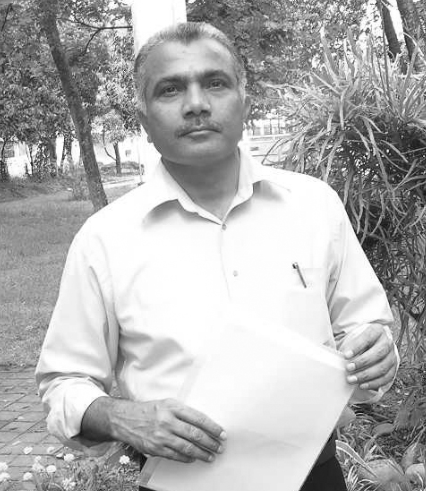Dev Raj Dahal, Kathmandu, Nepal
Regardless of circumstances Nepalese planners and decision-makers have blindly followed global patterns of economic thinking rather than evolving contextual policy suitable to its reality, basic values, and people’s needs.
Annual per capita income of $487 puts landlocked Nepal in the bracket of least developed country.
Squeezed between India and China, its largely impoverished population of 30 million lives predominantly in subsistence agriculture and informal economy where the concept of modern social security rarely exists.
The top five percent of households own 37 percent of agricultural land while the bottom 47 percent occupy only 15 percent of it. About 29 percent of households are sukumbasis, landless.
It reveals the structures of power relations that are at work in the marginalization of women, poor, and Dalits from the nation’s economic order.
Neo-liberal policy of the removal of subsidies on fertilizer, improved seeds, irrigation, and credit reduced agricultural productivity, increased rural poverty, and food scarcity.
Over 30 percent of economically active population is totally unemployed.
The organized sector is only 10 percent where workers’ minimum rights are guaranteed.
The average monthly minimum wage for workers ($87.32: $50 basic salary and $37.32 dearness allowance) is barely enough to feed even a nuclear family given average annual inflation rate of over 10 percent.
Daily wage for industrial worker is $3.25 while for agricultural worker it is yet to be decided (previous one is .
08).
Among the total employed, 46 percent of them get monthly salary, the rest are employed on contractual, weekly pay and daily wage basis.
Some 78 percent of population lives on less than $2 a day.
This monetary estimation of income is inadequate to fathom poverty which arises from a lack of opportunity for livelihoods, education, health care, safe water, sanitation, and social protection.
Maternal mortality stands at 281, fertility rate 3.1, and infant mortality rate is 48. Life expectancy at birth is 68.81 years. Adult literacy rate is 53.74 %.
Females’ educational level must be scaled up as it helps to stabilize population, eradicate poverty, and entitle every adult to get life’s possibilities.
The contribution of tax to GDP is only 12 percent which is insufficient to subsidize welfare, and create accountable and responsible governance.
In such a context, the government has “little incentive to build political and organizational capacity to negotiate and collect revenue and spend effectively” (Moore and Unsworth, 2007:1).
The commodity economy, increasing investment in urban banks, real estates, private schools, colleges, hospitals, and accumulation of gold, technological backwardness of society and domination of decision-making by powerful political and economic interests continue to pose structural obstacles for social transformation, and mitigate the food crisis constantly faced by about 4 million people.
The two decades of neo-liberalism carried by successive Nepalese governments of all political hues not only broke the welfare state’s labor-capital coordination but also trampled the constitutional vision of social justice.
It brought structural shift of the economy from agriculture and industry to financial capitalism.
Still, only about 26 percent of Nepalese have access over banking services due to their concentration in only urban nodes.
Worse still, unproductive sector lending, concentration of loan to few powerful persons, inability of the government to expand capital base, capital flight and problem of institutional governance do not promise financial stability in the short-run and productive economic growth.
Financial capitalism has made corporate and comprador classes vibrant, redistributed income and assets from the real to symbolic economy, labor to capital, the bottom to the top classes of society, and centralized population, capital and production in urban areas.
It has also caused fatal social, economic, and environmental consequences for the poor.
De-industrialization of real economy, deregulation of state control, slash of agricultural subsidy, and job layoffs, forced the globalization of the Nepalese workers in more than 100 countries of the world in the hope of smooth remittance flow.
Now agriculture growth remains only 1.1 percent but contributes 33 percent to GDP (over $422.54m), manufacturing sector growth is 2.7 percent while service sector contributes 52 percent to GDP.
Service provision, especially in education and health, is improving as community is increasingly involved in taking decisions.
But the establishment of private schools and hospitals on “economic model” producing two kinds of services and two kinds of citizens in the country with the risk of producing social and political polarization in the future.
The rent-seeking nature of privatization, and lack of self-determination of public policy have undermined the egalitarian virtues of democracy.

The rapid growth of labor force (400,000 per year), its demand for productive jobs, and basic goods cannot be met without revitalizing the real economy of countryside, and productive use of the remittance brought by over 3 million workers abroad which contributes 23.4 percent to the nation’s GDP.
The social and economic costs of Nepalese migrant workers, and their suffering and sacrifice have not been properly estimated nor did the utilization of their skills and funds (both wage capital and investment capital) in productive sectors of the economy.
Likewise, the migration of highly productive youth has caused the decline of agriculture, increased the cost of production, and turned the food surplus nation into deficit one.
This is making Nepal a consumption-oriented economy, which needs to be changed (Khanal, 2011:1).
The contribution of foreign aid to GDP is only 4.7 percent.
To annual government budget it accounts to 30 percent and about half of government’s capital expenditure.
Foreign debt burden hovers around $3565.14m and each year debt burden is increasing beyond its ability to pay.
Conversion of debt into equity is a major policy challenge. The average domestic savings rate in Nepal as a percentage of the total Gross Domestic Product (GDP) stands at 10 percent.
The acutely poor Nepal, sitting in one of the largest hydropower potential (83,000 MW) of the world, has so far produced only 697 MW of electricity (out of which leakage is 186 MW) which fails to meet even the current domestic demand of 900 MW.
The country is (was) facing acute energy crunch, 14-hour power cut every day thus hobbling the possibility for industrial development.
Political strikes and increasing production costs add other woes.
To boost faltering economy, and strengthen its fast losing international competitiveness, expansion of hydropower, and alternative source of energy is essential.
Decline of manufacturing in Nepal squeezed employment for workers and the country’s export competitiveness.
The contribution of manufacturing sector to GDP is only 6 percent.
The return of populism, security vacuum, and weak property rights scare both national and foreign direct investment in manufacturing sectors necessary for economic growth, technological progress, and social justice.
In this context, the solidarity of sub-national units to strengthen local self-governance with the capacity and autonomy to define local social, economic, and cultural development is essential.
State-building from below requires surplus region to help the deficit ones in the framework of national development.
Stabilizing climate requires schemes for converting wind, solar, hydro-power, biofuel, and geo-thermal power into cheap energy.
This also requires reordering fiscal priorities in response to the new threats to human security (Brown, 2006: 250).
Nepal’s annual economic growth of 3.2 percent barely balances population growth of 2.2 percent, reduces the level of poverty of around 65 percent and ensures social peace and stability.
Inequality and stifled opportunity have caused violence—individual and collective (Tilly, 2006:159) and massive shift of population from rural to urban areas which is already marred by congestion, shortage of water, poor sanitation and dirty air.
Nepal’s location between huge landmass of Asia-China and India, its entry into SAFTA, BIMST-EC, and WTO and stable relationship with EU have opened the prospect for increased market access of Nepalese products.
But, there are many non-tariff barriers, such as environment, labor and quality standards (Khanal, 2011: 1).
The increased market integration at the higher level would not be sustainable if it is not accompanied by societal goods, reduction of capital cost in production, social support of peasants and workers in environmental protection, and removal of internal barriers to national market integration.
Exploration of alternative energy can enhance Nepal’s security by reducing dependence on vulnerable oil supplies. Nepal would also gain political clout by boosting regional cooperation, pooling of regional resources to address post-state challenges, and fulfilling transformation.
“Markets have a strong tendency to reinforce the status quo.
This means that poor countries are supposed to continue with their current engagement in low-productivity activities.
But their engagement in these activities is exactly what makes them poor.
If they want to leave poverty behind, they have to defy the market and do the more difficult things that bring them higher incomes—there are no two ways about it” (Chang, 2008:210).
Its real problems are: inadequate infrastructures, lack of internal market integration, weak production, incapacity to supply, and poor standards of goods.
As a result, import is six times higher ($3.6billion) than exports causing annual trade deficit of $633.80m.
External aid has become essential to cover the balance of payment deficits, remove the gap in governance between security and development, and drum up support for peace building.
This means post-conflict Nepal needs leaders who have the vision and character to utilize external resources such as foreign aid, debt relief, and direct foreign investment for self-sustained development.
Weak politics has created dependency culture, and caused leadership failure in constructing rules, legal premises, and supportive policy for work and wages while alarming surge of strikes rendered the authority of government ineffective.
Nepalese state, therefore, needs to restore political authority through the intermediation of state institutions, solve problems of broad-based inclusive economic growth, bring opposing interest groups, and best talents to endorse the framework of social justice, and support economic actors’ competitive strength in market efficiency.
These are the necessary steps to heal the post-conflict society.
If Nepalese government is able to stabilize its economy, it will regain freedom of policy.
Future institutions require those leaders who provide “combinations of spiritual, emotional, and material rewards meeting the needs of people who are already seeking to participate in simplifying and purifying the world” (Tilly, 2006: 169).
But it remains unclear where the new leadership will come from when the society is now being re-tribalized, and politics is used to extract economic rents.
Strengthening national economy is essential to strengthen the state’s capacity to deliver.
End text.
##############################################################################
# Excerpts of paper presented by the author at GEFONT Seminar as back as in July 10-11, 2011 on Shaping Tomorrow’s Economy Challenges and Choices for Nepal.
# Thanks the distinguished author Mr. Dahal. Article published in the larger interests of the readers here and abroad. Upadhyaya.

